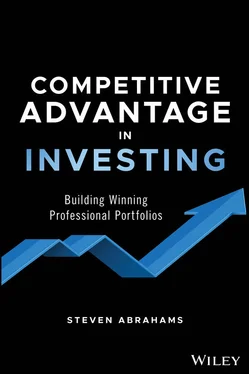Portfolios that recognize strengths and weaknesses improve their chances of earning sustainable returns beyond those of broad market averages. In practice, most portfolios specialize in their strengths. This usually gets little attention in formal theory, which often relies on the simplifying assumption that all investors have the same information and investment capacities. Of course, this also implies that no investor can deliver consistent excess return and that no portfolio can sustain advantage.
Competitive advantage also figures in anticipating the plausible future states of the world, which is central to good investing. After all, future economic growth, interest rates and lending terms, hedging, information flow, taxes and accounting rules, political and regulatory changes, technology, and so on all shape investment returns. Some portfolios have comparative advantage in anticipating this kind of change. And, empirically, the time and effort spent by investors on forecasting attests to the importance of anticipating a probabilistic future.
Finally, competing portfolios shape the value of different assets all the time. Formal finance acknowledges the idiosyncrasies of preferred risk and return across investors. But once institutional constraints lead large blocks of capital to adopt similar preferences, then the idiosyncrasies of individual portfolios coalesce into systemic influences on asset value. Investors will demand compensation for these systemic influences. Among other things, the value of the US Treasury market, the agency mortgage-backed securities market, and the corporate debt market, among others, have been shaped in the last few decades by episodes of major institutional capital flow responding less to return, risk, and correlation than to policy and regulation.
This book brings together investment theory, practice, and markets to explain the differing goals of professional investment portfolios, the sources of competition between them, and the impact of competition on asset value. For theorists, it adds to the list of systemic factors that drive asset value by breaking global asset markets into local ones. For practitioners, it frames the business of investing as a competition with other portfolios operating under similar constraints. For market analysts, it details the ways that scale, leverage, funding, hedging, information, tax and accounting, and regulation and politics can suddenly shift the playing field.
The book starts with the ideas that brought investing into the modern era. Harry Markowitz revolutionized investing by changing it from an exercise in calculating present value into one of balancing risk, return, and diversification. William Sharpe and his peers then built on work by Markowitz and others to develop the capital asset pricing model, or CAPM. CAPM would offer a beautiful theory of investing but arguably one that hid as much as it revealed.
In the half-century after CAPM's debut, its critics would steadily pile up one piece of evidence after another showing shortfalls in the model's description of markets. Analysts at universities and across Wall Street would offer expanded versions of CAPM to explain the anomalies. The local capital asset pricing model, introduced here, is one such version. Local CAPM explicitly builds in competitive advantage and disadvantage across portfolios and their impact on asset value. The sources of advantage and disadvantage are specific and their impact unique.
From investment theory, the book swings into analysis of the broad investment platforms and special vehicles that dominate markets. Mutual funds and hedge funds compete to generate total returns. Banks and insurers manage asset portfolios against a series of specific liabilities. Broker/dealers stand between investors but still extract investment return and shape markets. Real estate investment trusts and sovereign wealth funds reflect the impact of mixing public policy with investment portfolios. And the potential advantages that individual investors might have in highly competitive markets get treatment here as well.
This guide is for researchers who want a better model for the observed behavior of investors. This is a guide for practicing investors who want a better, formal framework for managing the investment process and building a competitive business. This is also for students of markets who want to understand how the behavior of investors can shape the value of assets.
Kurt Lewin, the psychologist, noted that there is nothing so practical as a good theory. A good theory organizes facts and simplifies and explains an otherwise complex landscape without diminishing its most important features. The book you are about to read takes a resolute step in that direction.
Steven Abrahams
September 9, 2019
The 2008 financial crisis planted the seeds for this book. I was at Bear Stearns watching everything going on around me in the markets and covering much of it as part of Bear's fixed income research team. My job let me range across different markets and talk to different investors in the US and abroad. It had been the case throughout my Wall Street career that advantages and disadvantages mattered in investing, and the crisis made it especially clear. When Bear collapsed, I decided to try to relay some of what I had learned to a new generation.
Glenn Hubbard, dean at the Columbia Business School, and Galen Hite, who organized the adjunct faculty for him, warmed to the idea of a course that would focus on ways that different institutional portfolios dealt with markets. They gave me the chance to design and offer the course, and I took it. I've been grateful ever since.
From that first semester, the students at Columbia Business School taught me as much as I taught them. There was no precedent for the course, much less a book, so I started doing the background work and developing the materials that evolved over the years into these pages. The students contributed excellent ideas, challenged me to hone my own, and taught me that a good lecture is as much a performance as anything else. I thank them for the education.
The clients and colleagues that explained the way different portfolios work, or just showed me by analyzing the same markets in such different ways for such different reasons, also deserve thanks. My list of contacts, which I've kept carefully since my first day on the Street, runs into the thousands. They all deserve some credit. The job of analyst has always seemed an extraordinarily good place to satisfy curiosity. Morgan Stanley, Bear Stearns, Deutsche Bank, and Amherst Pierpont have given me the opportunity. I've taken full advantage.
Some friends in the business deserve specific mention for carefully reading sections of this book and offering thoughtful comments. Richard Dewey, Albert Papa, Glenn Perillo, and Robert Thompson kindly read parts of the manuscript on tight deadline. Of course, any shortfalls or errors in this book are entirely mine.
Kevin Harreld, Michael Henton, and Richard Samson at John Wiley & Sons have encouraged me throughout the drafting of this manuscript and worked with me patiently to get all the details right for publication. To my partners at Wiley, thank you.
As for my family, I thank them for the time on nights and weekends I needed to work through the book, for their support and encouragement, and for the beautiful spot by the lake in New Jersey where much of the writing took place and where all good things happen.
Steven Abrahams
September 9, 2019
Part I Theory
1 Welcome, Harry Markowitz
In the Beginning
Imagine a simple beginning. You have some spare cash. You have covered your daily cost of living and other bills, and it's rattling around in your pocket. You start thinking about what you might do with it. Other than spend it, that is. That is the beginning. With that thought, you have become an investor.
Читать дальше












